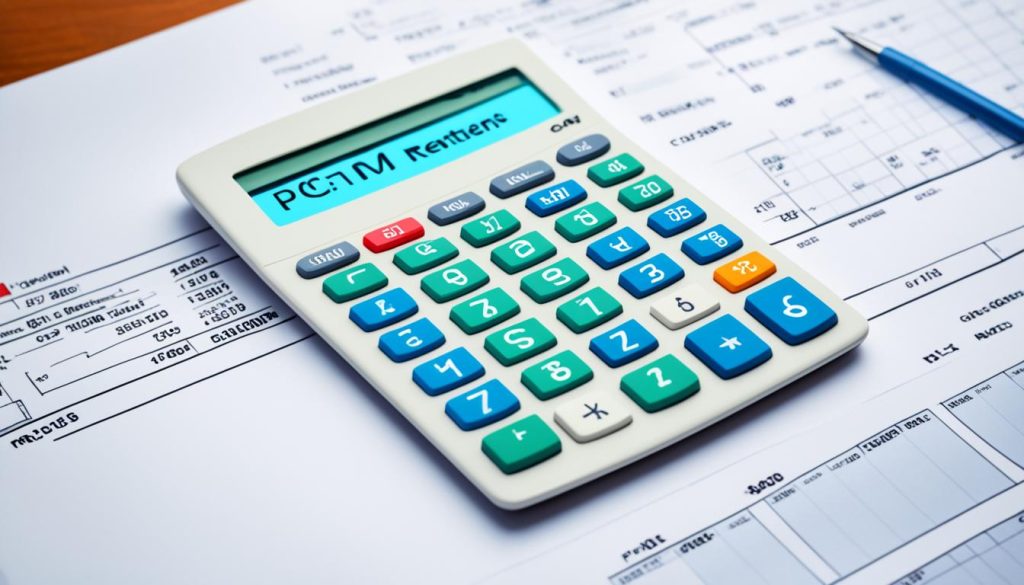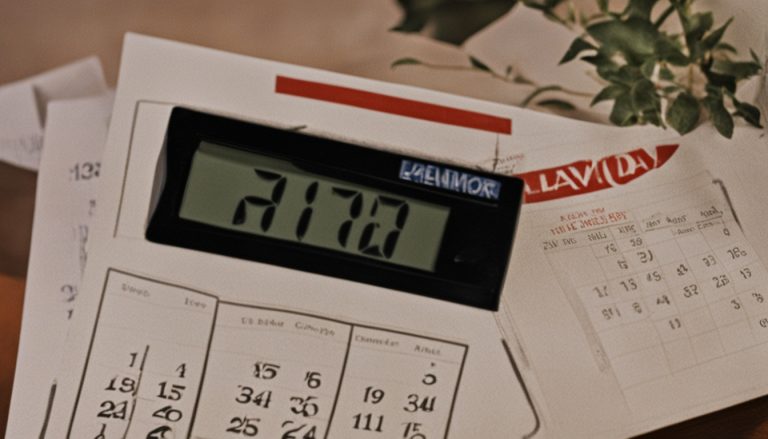Did you know that in the United Kingdom, over 60% of all rental properties are leased using the ‘PCM’ rental term? This widespread usage of the PCM acronym highlights the importance of understanding its meaning for both tenants and landlords navigating the property rental market.
PCM stands for ‘Per Calendar Month’ and is a common rental term used in the UK housing sector. It refers to the frequency of rent payments, indicating that the rent is due on the same date every month. The PCM system assumes the occupant will be in the property for 30 days, though the 30-day period does not necessarily have to start on the first day of the month. Regardless of the month’s length, the same total rent is paid each month under a PCM arrangement.
Understanding the PCM rental term is crucial for tenants and landlords to ensure a smooth rental process and avoid any confusion or miscommunication around rent payments. In the following sections, we’ll delve deeper into the PCM definition, its benefits, and how it compares to other rental payment methods.
What Does PCM Mean When Renting?
When renting a property, you may come across the abbreviation “PCM” – but what does it actually mean? PCM stands for “Per Calendar Month”, and it refers to the frequency of rent payments. In other words, when a rental agreement specifies a “PCM” rate, it means the rent is due on the same date every month, typically the first of the month.

PCM Definition and Explanation
The “PCM” rent payment structure assumes the occupant will be in the property for 30 days, though the 30-day period does not necessarily have to start on the first day of the month. This is a common arrangement for long-term rental leases, as it provides a consistent and predictable payment schedule for both the tenant and the landlord.
PCM Usage in Long-Term Leases
PCM is primarily used for long-term rental agreements, such as 6-month or 12-month tenancies. This payment structure allows tenants to budget their finances more easily, as the rent amount remains the same each month. Landlords also benefit from the predictability of regular, monthly rent payments, which can simplify their own financial planning and property management.
Understanding the meaning of “PCM” when renting is crucial, as it helps tenants and landlords alike navigate the terms of their rental agreement and ensure a smooth, transparent transaction. By familiarising themselves with common rental abbreviations like PCM, renters can make more informed decisions and better manage their housing costs.
Benefits of PCM Rental Rates
Renting a property with a monthly payment model, also known as “PCM” (per calendar month), can offer a range of benefits for both tenants and landlords. This flexible approach to rental agreements caters to the diverse needs of the rental market, from short-term accommodation for travellers to long-term leases for families and professionals.
Flexibility for Tenants and Landlords
One of the primary advantages of PCM rental rates is the flexibility they provide. Tenants seeking short-term or temporary accommodation, such as students, backpackers, or those relocating for work, often find PCM leases to be a perfect fit. These monthly agreements allow for greater mobility and the ability to adapt to changing circumstances, without the long-term commitment required by traditional annual leases.
Landlords also benefit from the flexibility of PCM rental rates, as they can more easily accommodate changing tenant needs and market demands. This can be particularly useful for property owners catering to seasonal or transient tenants, or those looking to optimise occupancy rates and minimise vacancies.
Streamlined Finances and Rent Payments
The PCM rental model also simplifies the financial management for both tenants and landlords. Tenants can more easily budget their monthly expenses, as the rental payment is a predictable and consistent part of their outgoings. Landlords, on the other hand, can benefit from a steady and reliable stream of rental income, which can be beneficial for cash flow and long-term financial planning.
Additionally, the monthly payment structure of PCM rentals can make it easier for tenants to manage their finances, as it aligns with the typical pay cycle for many employees. This can be particularly advantageous for those who may struggle with the larger lump-sum payments often associated with annual lease agreements.
| Term | Definition | Example Usage |
|---|---|---|
| PCM | Per Calendar Month | The rent for this property is £1,200 PCM. |
| PW | Per Week | The weekly rent for this flat is £280 PW. |
| PA | Per Annum | The annual rent for this house is £15,000 PA. |
By understanding the meaning of PCM and other common rental abbreviations, you can make informed decisions and navigate the rental market with ease.

Calculating PCM Rents
When it comes to rental agreements, the term “PCM” is a common abbreviation that stands for “per calendar month.” This metric is widely used in the property market to denote the monthly rent payable by a tenant. But how exactly are these PCM rental rates calculated?
Monthly Calculation for Annual Leases
For rental contracts with a duration of at least one year, landlords typically calculate the PCM rent by dividing the total annual rent by 12 months. This means that tenants will pay a slightly higher rate per month during shorter months like February, but a slightly lower rate in months with 31 days.
The rationale behind this approach is to provide a consistent and predictable monthly payment for the tenant, rather than fluctuating amounts. It also helps the landlord to manage their cash flow and budget more effectively over the course of the year.
| Rental Period | Annual Rent | PCM Rent |
|---|---|---|
| 12 months | £12,000 | £1,000 |
| 12 months | £15,000 | £1,250 |
| 12 months | £18,000 | £1,500 |
This straightforward approach to calculating PCM rents helps to provide clarity and consistency for both tenants and landlords throughout the duration of the lease agreement.

Factors Influencing PCM Rental Costs
The cost of renting a property based on the “per calendar month” (PCM) model is influenced by a variety of factors. Understanding these key considerations can help tenants and landlords alike make informed decisions when it comes to negotiating and agreeing on PCM rental rates.
Property Size, Condition, and Location
One of the primary drivers of PCM rental costs is the size, condition, and location of the property. Larger properties, particularly those with multiple bedrooms, typically command higher PCM rents. Similarly, the overall condition of the property, including its age, level of maintenance, and any recent renovations, can significantly impact the rental price.
The location of the property is another crucial factor. Properties situated in desirable areas, such as city centres, popular neighbourhoods, or near sought-after amenities and transport links, often have higher PCM rents compared to properties in less convenient or in-demand locations.
Included Amenities and Services
The range of amenities and services included in the PCM rental price can also influence the overall cost. Properties that offer additional features, such as on-site parking, concierge services, or access to shared facilities like gyms or communal gardens, may command higher rental rates.
Conversely, properties with limited or no amenities may have more affordable PCM rents, as tenants are not paying for those extra features. Understanding the specific inclusions and exclusions within the PCM rental agreement is essential when comparing and evaluating potential properties.
| Factor | Impact on PCM Rental Costs |
|---|---|
| Property Size | Larger properties typically have higher PCM rents |
| Property Condition | Well-maintained and recently renovated properties often have higher PCM rents |
| Property Location | Properties in desirable areas command higher PCM rents |
| Included Amenities and Services | Properties with additional features and services tend to have higher PCM rents |

PW Rent Meaning
Comparing PCM and PW (Per Week) Rental Agreements
When it comes to renting a property, two common rental payment structures are PCM (Per Calendar Month) and PW (Per Week). Understanding the differences between these two approaches can help tenants and landlords choose the option that best suits their needs.
PCM rental agreements are the more prevalent option, where the rent is calculated and paid on a monthly basis. This structure is often preferred for long-term tenancies, providing a predictable and stable payment schedule for both parties. In contrast, PW rental agreements are more common with short-term tenants, such as university students or seasonal workers, as they offer greater flexibility.
With a PW rental agreement, the rent is paid on a weekly basis, typically on a set day of the week, rather than a monthly lump sum. This can be advantageous for tenants who receive their income weekly, as it aligns better with their cash flow. However, it may require more diligent budgeting and record-keeping compared to a monthly payment system.
| Rental Agreement | Payment Frequency | Typical Tenancy Length | Key Advantages |
|---|---|---|---|
| PCM (Per Calendar Month) | Monthly | Long-term | Stable, predictable payment schedule |
| PW (Per Week) | Weekly | Short-term | Flexible, aligned with weekly income |
Ultimately, the choice between PCM and PW rental agreements will depend on the specific needs and preferences of both the tenant and the landlord. Tenants should carefully consider their financial situation and preferred payment schedule, while landlords may need to balance the stability of longer-term leases with the flexibility offered by weekly payments.
Conclusion
In summary, the term PCM (Per Calendar Month) is a widely used rental abbreviation in the UK housing market. It refers to the frequency of rent payments, indicating that the rent is due on the same date every month, with the assumption that the occupant will be in the property for 30 days. Understanding the PCM terminology is crucial for both tenants and landlords when navigating the rental landscape, as it provides clarity on the payment structure and helps streamline the rental process.
Whether you’re a tenant searching for your next property or a landlord managing your rental portfolio, familiarising yourself with the PCM definition and its implications is essential. By recognising the PCM meaning and how it impacts rental agreements, you can make informed decisions, plan your finances effectively, and ensure a seamless rental experience.
As the UK’s rental market continues to evolve, staying informed about the common terminology, such as PCM, will empower you to navigate the rental process with confidence and make the best choices for your housing needs or investment goals. With a clear understanding of what PCM means when renting, you can confidently engage in rental negotiations, manage your monthly finances, and ensure a smooth and successful tenancy.
FAQ
How is PCM rent calculated for annual leases?
If the rental agreement is for at least a year, the landlord usually calculates the PCM rent by dividing the annual rent by 12. This means the occupant pays a slightly higher rate per month in shorter months like February, but a slightly lower rate in months with 31 days.
What are the benefits of PCM rental rates?
PCM rental rates can benefit a variety of tenants, from families and students to backpackers, especially for short-term accommodation needs. A 30-day PCM lease could be a perfect short-term solution for those travelling abroad, providing flexibility and streamlined finances.
How does PCM differ from PW (Per Week) rental agreements?
PW rental agreements are more common with short-term tenants, such as university students or seasonal workers, as they allow for more flexibility. With a PW agreement, the rent is paid on a weekly basis, typically on a set day of the week, rather than a monthly basis.
What factors influence the PCM rental costs?
The PCM rent for a property is determined by various factors, including the size, condition, and location of the property. The average PCM rent in London is around £1,750, which is approximately 40% higher than the UK national average.






